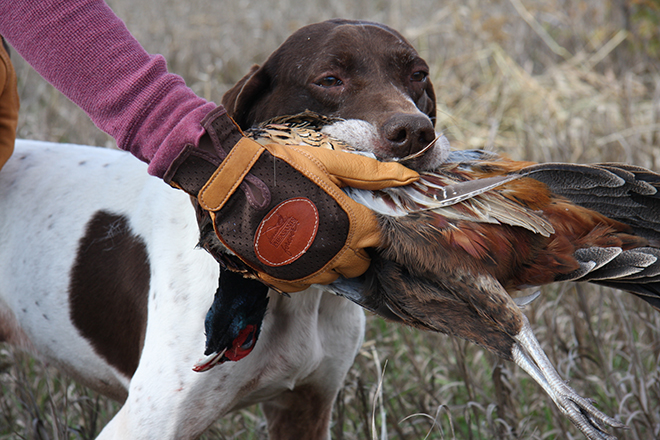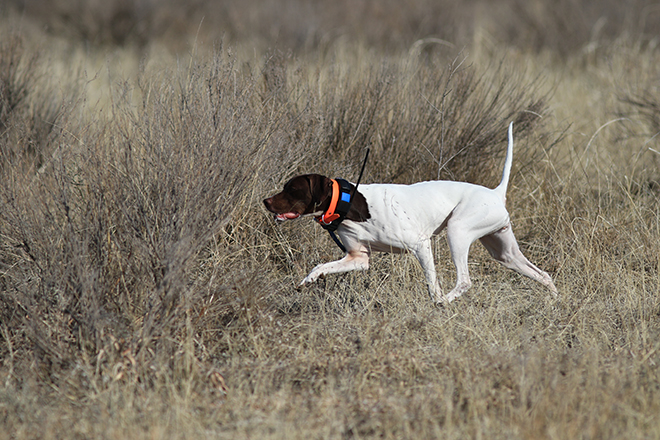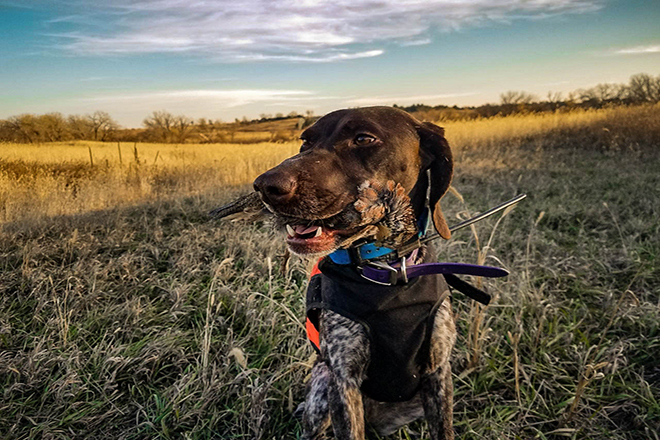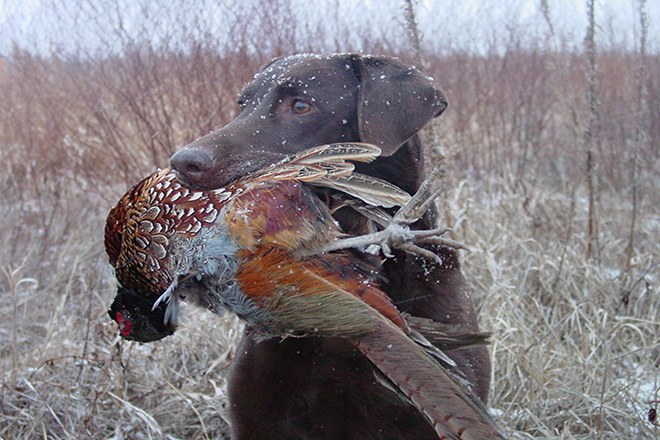By Curtis Niedermier
Here’s a scenario you’ve probably experienced: Your dog points a covey of quail, and on the flush, you shoot one of the birds. It would be a joyful moment except, rather than retrieving the quail you shot, your dog is now racing off after the rest of the birds.
Cruel reality, right? But it doesn’t have to be. Here’s a primer on getting your dog to “hunt dead.”
Puppy Steps
Dan Wittman, a Quail Forever member from Phoenix, is the director of testing for the North American Versatile Hunting Dog Association (NAVHDA), so he knows better than most what a gundog is capable of doing in the field.
According to Wittman, the foundation for tracking and hunting dead, which go hand in hand, can be laid during the puppy stage, beginning as early as the day the pup comes home by using food rewards to encourage the pup to start searching or following a track.
Every step of the process builds gradually on the one before it.
“You want to get their nose ‘turned on,’” says Wittman, referring to a dog’s natural ability to follow a scent trail. “A lot of people use hotdogs. You put a line of hotdog pieces out in a yard, with a bigger piece at the end, and let the dog follow the ‘track.’ Eventually, you spread the different pieces farther apart. Then you just drag the hotdog and have the bigger pieces at the end.”
Once the pup graduates from hotdog level, Wittman drags a dead bird. He leaves a pile of feathers at the start of a track and drags the bird with the pup watching. Then he takes the pup to the feathers and lets it track the bird. Wittman repeats the process in the next step but without letting the pup see the bird.
After that, Wittman switches to a live bird – usually a pheasant, but a chukar can work, too.
“You pull the flying feathers out of a pheasant and let the pheasant run off,” he says. “The pup tracks the foot scent. That’s how I build up to it.

“When they find it, I’ll get down on my knees and praise them and really celebrate the fact that they found that bird.”
Success Breeds Confidence and Trust
Though tracking isn’t always part of the process of hunting dead, it certainly can be, and these simple tracking drills are easy places to start building trust and confidence in a young dog to believe that every time a hunter gives it a command to hunt dead, there’s something out there worth finding.
If a pup is struggling to follow the track, keep it on a long lead and guide it back whenever necessary.
“You have to have control initially to get them to come back and follow that scent,” Wittman says. “You’ll see a lot of younger dogs, and they’re amped up. You let them loose, and they don’t even concentrate at all. They don’t acknowledge the track. They’re off like they’re searching for a covey of birds. You have to show what you want.”
Wittman builds in assurances that the dog will be successful even when he’s handling more advanced dogs that need to follow a track out of sight of the handler.
“If they start coming back without the bird, I start walking toward them,” Wittman adds. “Of course, when you do that, they’re going to turn around and keep searching. You want to try to make them successful.”
Once he sees the dog can concentrate on the task – when it’s following the track or hunting for a dead bird with purpose – Wittman adds in the verbal command “easy,” which he’ll use in the field to tell the dog to start hunting dead. You might prefer a different command such as “dead,” “dead bird” or “find it,” but the specific word matters less than how you use it.
.JPG.aspx)
“The way I say it to them when I’m doing this is ‘eeeasy,’” Wittman says. “I drag that out a little bit to try to slow them down. And I’ll tap on the ground to get them to see where I want them to start.”
From Tracking to Hunting Dead
With the basic tracking foundation in place, the next step is to expand to hunting dead. Here again, the dog needs to cover ground with a purpose, but it shouldn’t be searching for another covey. It should be looking for the dead bird.
To start, he’ll put out multiple birds for the dog to find.
“You could drag or place a bird or however you want to do it, but instead of having one bird, why not put out five birds so no matter where that dog goes it’s going to be successful?” Wittman says. “Stack the odds in favor of the dog not leaving the area without finding a bird.”
Over time, the challenge increases and so does the length of the exercise. But at every step, Wittman has a plan to help the dog succeed.
“It’s about trust: If I tell you to go get something, there’s something there. You just have to work at getting there.”

Most hunters won’t need to go far beyond this point, but there are certain things Wittman suggests everyone try: 1) Move your training around to different areas, 2) when possible, try to train in terrain and cover that mimic where you’ll hunt, and 3) introduce the dog to multiple distractions and challenges – what Wittman calls “curveballs.”
“If you’re not exposing them to that situation when you’re training, then how do you expect them to know what’s going on when you’re hunting?” Wittman says. “I’ll carry pigeons with me, and as the dog is running back toward me or crossing in front of me, I’ll whip out a pigeon to demonstrate stop to flush. Well, I do the same thing in training when they’re on point. Sometimes I’ll put a couple pigeons out, and when they’re flying away, I’ll shoot the last one. The dog has to concentrate enough to retrieve the one I shot. If you’re not throwing them curveballs, it gets boring.”
Putting it in Play
With some foundation work in place, putting everything to work in the field involves a little strategy by the hunter and a lot of execution by the dog.
If his dog doesn’t mark a bird down or Wittman knows the bird is running, he increases the dog’s chances by calling or heeling it close to where he marked the bird but always on the downwind side, so the dog can use the wind to its advantage.
In a multiple-retrieve scenario, he might calm the dog between birds by giving it a drink (which also helps clear out any feathers) and then sending it to find the next bird.
The rest is up to the dog.
Be Positive and Realistic
Wittman’s methods rely on having access to training birds and a variety of large training grounds. You might not have that luxury, and that’s OK. If you consider the key points he emphasizes – building confidence and trust through success – you can probably design a few training exercises that work for your situation.
You don’t need a coop full of homing pigeons to gush praise on your dog when he finds the bumper you hid in your neighbor’s rose bushes, or to stay positive in the field when the dog is struggling.
That last point is a big one with Wittman.
“Part of the problem I find with some individuals is they put a lot of pressure on the dog,” he says. “Is the dog not finding the bird you want them to track because they’re just not good at it, or because they’re frustrated and bored with the way you’re training them and just want to move on?”

Finally, whenever you’re training, whether a puppy or a mature dog, take baby steps.
“I always tell people it’s not rocket science,” says Wittman. “The problem most people have is they move to the next step before they’re ready. Then they start having holes in the program.”
This story originally appeared in the Summer 2020 issue of Quail Forever Journal. If you enjoyed it and would like to read more great bird dog content,
become a member today!